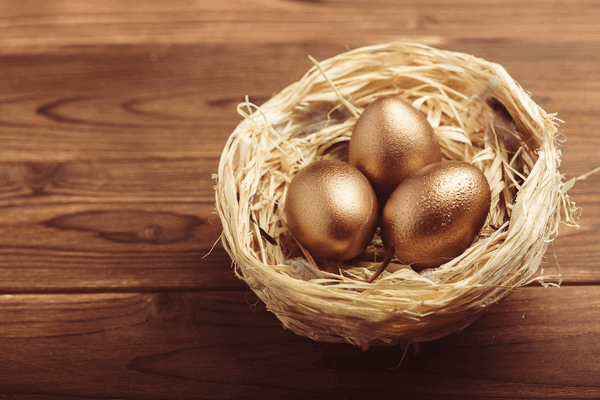Gold individual retirement accounts function similarly to the traditional ones, and the IRS approves them. However, unlike the conventional retirement accounts like 401(k)s that limit the products that you can invest in, a self-directed IRA account will let you put your money into precious metals for diversification. You can learn more about a 401(k) on this site here.

In accounts where you and your company contribute to your retirement fund, you may be limited to putting your money on bonds, mutual funds, and paper assets. Gold IRA will allow you the added benefit of going with gold coins, bars, silver, palladium, and platinum metals.
Benefits to Know About
By putting a small percentage of your IRA into gold, you’re essentially diversifying your portfolio. This is on a tax-deferred basis where you effectively retain a preferential treatment for taxes. When you roll over a portion of the funds in your traditional IRA into your gold IRA, this won’t trigger you to pay taxes or penalties.
Typically, people get gold and other precious metals to hedge against market downturns, inflation, and political unrest. However, know that the bars don’t give you a monthly cash flow while they are sitting inside your custodian’s safe. Another thing is that when you reach 72 years old, you may have to take an RMD or required minimum distribution.
A required minimum distribution will involve selling a part of your bullion, especially if it’s the only IRA you have. See more about an RMD here: https://www.forbes.com/advisor/retirement/required-minimum-distribution-rmd/. It makes sense to diversify some of your funds into stocks, bonds, and mutual funds to act as a hedge against inflation. With the strategies that you have with your financial advisor, you can better plan for your future and implement a sounder plan.
More Information about Gold IRAs
With Roth or traditional IRAs, you’ll usually invest your savings in securities, mutual funds, bonds, and stocks. With the gold IRA that’s self-directed, you have the option to own specific gold and silver coins, bullions, platinum, and palladium. The procedures are the same as with any other IRAs for contributions, taxes, and disbursements.
The account holders may choose to put their money in other paper assets like exchange-traded funds (ETFs), mining companies, mutual funds involving precious metals, and commodity futures. It’s worth noting that these instances are rare as SDIRA are often opened so that the investors can get tangible assets like bars and coins.
What are the Eligible Precious Metals?
Know that not all shiny metals will qualify, even if you want them to include in your IRA account. Some coins or bars should meet the acceptable standards that are set by the IRS. Specifically, the purity of platinum and palladium should be 0.9995%, gold should be 0.9950%, and silver should be 0.9990%. Some of the breakdowns of eligibilities are discussed further below:
Gold
- American Eagle Coins
- Canadian Maple Leaf Coins
- PAMP (Produits Artistiques Métaux Précieux) Suisse bars
- Australian Kangaroo Coins
- Austrian Philharmonic Coins
- Uncirculated Gold Buffalo Coins
- Bars approved by a refiner or produced by the national government mint
Silver
- Mexican Libertad coins
- Canadian Maple Leaf
- American Eagle
- Australian Kookaburra Coins
- Specific bullions and bars approved by a refiner or produced by the national government mint
Palladium
- Canadian Maple Leaf
- Certain palladium bullions
Platinum
- -Canadian Maple Leaf
- -Isle of Man Noble Coins
- -American Eagle Coins
- -Bars and bullions approved by the national government
Aside from the specific acceptable coins and bullions, you need to know what coins are not allowed. Some of these metals that are deemed unacceptable are the following:
- Belgian Francs
- Italian Lira
- Chilean Peso
- Hungarian Korona
- Austrian Corona
- British Sovereign and Britannia
- Swiss Franc
- Mexican Peso
- South African Krugerrand
- Mexican Peso
- Dutch Guilder
Opening an Account

For you to open an account, choose custodians who can hold the physical bars and gold metals for you. The custodians must have a depository approved by the IRS, which is different from a regular savings account. You need to call the nearest brokerage firm, credit union, trust company, or bank, and they should be able to recommend a legitimate custodian for your account.
You need custodians who will hold on to your gold for a very long time since this will be until you retire. This can be equivalent to a long-term commitment, and this is why you need to look for established ones that have been operating in your area for decades. It’s better if you have a site to compare gold ira companies and choose based on the most trustworthy ones according to website reviews. With this said, there are several firms where you can create a stable relationship and offer excellent services to cater to your needs.
The good news is that you don’t have to do everything alone, especially if this is your first time opening an account. There are brokers and financial advisors that can help you out. Companies are happy to serve and help you go through the steps in opening an SDIRA, and this account can be used against a hedge in inflation.
Before investing, you need to be sure that this type of IRA is best for you. Typically, the value of the gold bars rises when the value of the dollar comes down. If this investment makes you apprehensive overall, it’s better if you have some of your funds in precious metals. You should also factor in the tax savings and other benefits that you’ll get when you retire.

